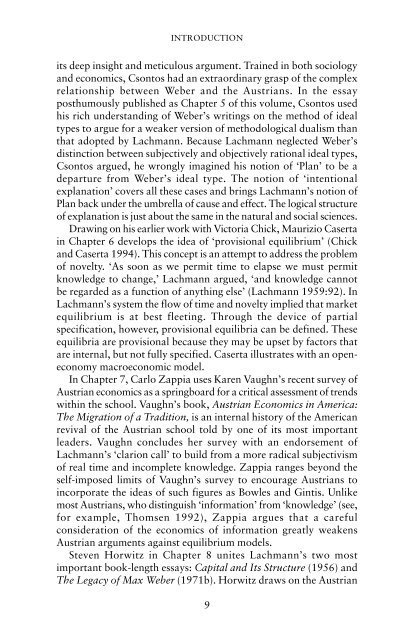Subjectivism and Economic Analysis: Essays in memory of Ludwig ...
Subjectivism and Economic Analysis: Essays in memory of Ludwig ...
Subjectivism and Economic Analysis: Essays in memory of Ludwig ...
You also want an ePaper? Increase the reach of your titles
YUMPU automatically turns print PDFs into web optimized ePapers that Google loves.
INTRODUCTIONits deep <strong>in</strong>sight <strong>and</strong> meticulous argument. Tra<strong>in</strong>ed <strong>in</strong> both sociology<strong>and</strong> economics, Csontos had an extraord<strong>in</strong>ary grasp <strong>of</strong> the complexrelationship between Weber <strong>and</strong> the Austrians. In the essayposthumously published as Chapter 5 <strong>of</strong> this volume, Csontos usedhis rich underst<strong>and</strong><strong>in</strong>g <strong>of</strong> Weber’s writ<strong>in</strong>gs on the method <strong>of</strong> idealtypes to argue for a weaker version <strong>of</strong> methodological dualism thanthat adopted by Lachmann. Because Lachmann neglected Weber’sdist<strong>in</strong>ction between subjectively <strong>and</strong> objectively rational ideal types,Csontos argued, he wrongly imag<strong>in</strong>ed his notion <strong>of</strong> ‘Plan’ to be adeparture from Weber’s ideal type. The notion <strong>of</strong> ‘<strong>in</strong>tentionalexplanation’ covers all these cases <strong>and</strong> br<strong>in</strong>gs Lachmann’s notion <strong>of</strong>Plan back under the umbrella <strong>of</strong> cause <strong>and</strong> effect. The logical structure<strong>of</strong> explanation is just about the same <strong>in</strong> the natural <strong>and</strong> social sciences.Draw<strong>in</strong>g on his earlier work with Victoria Chick, Maurizio Caserta<strong>in</strong> Chapter 6 develops the idea <strong>of</strong> ‘provisional equilibrium’ (Chick<strong>and</strong> Caserta 1994). This concept is an attempt to address the problem<strong>of</strong> novelty. ‘As soon as we permit time to elapse we must permitknowledge to change,’ Lachmann argued, ‘<strong>and</strong> knowledge cannotbe regarded as a function <strong>of</strong> anyth<strong>in</strong>g else’ (Lachmann 1959:92). InLachmann’s system the flow <strong>of</strong> time <strong>and</strong> novelty implied that marketequilibrium is at best fleet<strong>in</strong>g. Through the device <strong>of</strong> partialspecification, however, provisional equilibria can be def<strong>in</strong>ed. Theseequilibria are provisional because they may be upset by factors thatare <strong>in</strong>ternal, but not fully specified. Caserta illustrates with an openeconomymacroeconomic model.In Chapter 7, Carlo Zappia uses Karen Vaughn’s recent survey <strong>of</strong>Austrian economics as a spr<strong>in</strong>gboard for a critical assessment <strong>of</strong> trendswith<strong>in</strong> the school. Vaughn’s book, Austrian <strong>Economic</strong>s <strong>in</strong> America:The Migration <strong>of</strong> a Tradition, is an <strong>in</strong>ternal history <strong>of</strong> the Americanrevival <strong>of</strong> the Austrian school told by one <strong>of</strong> its most importantleaders. Vaughn concludes her survey with an endorsement <strong>of</strong>Lachmann’s ‘clarion call’ to build from a more radical subjectivism<strong>of</strong> real time <strong>and</strong> <strong>in</strong>complete knowledge. Zappia ranges beyond theself-imposed limits <strong>of</strong> Vaughn’s survey to encourage Austrians to<strong>in</strong>corporate the ideas <strong>of</strong> such figures as Bowles <strong>and</strong> G<strong>in</strong>tis. Unlikemost Austrians, who dist<strong>in</strong>guish ‘<strong>in</strong>formation’ from ‘knowledge’ (see,for example, Thomsen 1992), Zappia argues that a carefulconsideration <strong>of</strong> the economics <strong>of</strong> <strong>in</strong>formation greatly weakensAustrian arguments aga<strong>in</strong>st equilibrium models.Steven Horwitz <strong>in</strong> Chapter 8 unites Lachmann’s two mostimportant book-length essays: Capital <strong>and</strong> Its Structure (1956) <strong>and</strong>The Legacy <strong>of</strong> Max Weber (1971b). Horwitz draws on the Austrian9

















